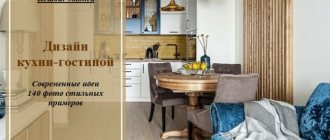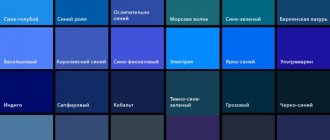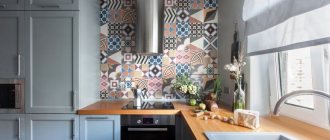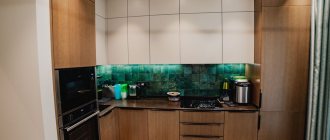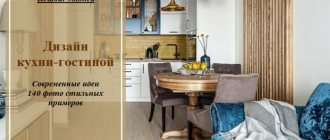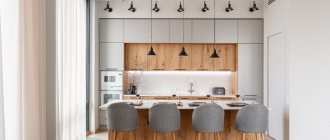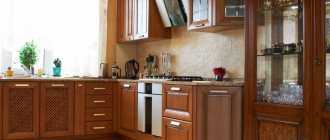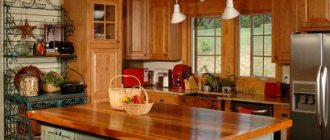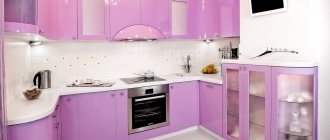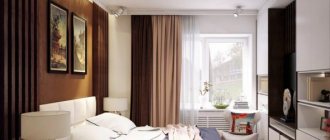Blue color can completely transform a space, filling it with freshness and lightness. A variety of shades allows you to choose the ideal option for any room, including the kitchen. Blue is calming and reduces appetite, but can also look completely uncomfortable and out of place if used incorrectly. Let's learn how to correctly use color in the interior of a blue kitchen, and get inspired by photos of interesting solutions.
Characteristics and features of blue color
Most people recognize this color as calming and peaceful, but when it comes to its use in the interior, the impressions can be completely different:
- Too many rich and bright blue tones can be annoying. It is important to maintain a balance of light and dark, that is, the thicker and darker the blue, the more light areas and details there should be in the interior. Imagine a small blue-black monochrome kitchen with bulky furniture in the same shades. Gloomy place, isn't it?
- Blue needs a partner. At the same time, the color of the sky can act as a primary, additional, or simply decorative color - it is very universal. The ideal proportions are as follows - 60% primary color, 30% additional and 10% decor.
- Blue needs good lighting. During the day, a powerful stream of sunlight enters the kitchen, so it is better to leave only a thin curtain on the windows or leave it completely “naked”. As soon as it gets dark, numerous lamps take the initiative - chandeliers, sconces, floor lamps, spotlights, and so on.
- Blue actively affects the temperature of the room. If it brings coolness on a hot day, then in winter you can freeze, so it is necessary to add warm colors to the interior.
Blue dulls the feeling of hunger, so a person will eat less. In addition, the taste of the dishes may be distorted, but there is nothing harmful in this - especially if the owners have long wanted to lose weight. For better results, you should also buy blue dishes.
Advantages and disadvantages
Although blue is considered a universal color, it is also complex. It has a lot of positive aspects, but there are also negative ones. Before choosing it for your kitchen, you should familiarize yourself with all its characteristics.
Reasons to say yes to blue include:
- calming effect if applied in the right amount;
- decreased blood pressure;
- beneficial effect on intellectual work;
- creating the effect of rigor and nobility;
- creating a fresh atmosphere;
- visual change of the room - for example, you can narrow it and lengthen it;
- Great for almost any style, but especially for Scandinavian, Mediterranean, Art Deco and Empire.
But there are also negative sides to this solution:
- a decrease in appetite is good only for those who want to lose weight, but children with their growing bodies do not need such an effect;
- must be used with caution on northern windows to prevent the creation of an “icy” room - be sure to add warm beige, yellow or orange shades;
- if there is little natural light, a chamber effect may appear;
- if the kitchen is too spacious, then blue can make it even larger - a feeling of emptiness will appear, and the comfort will disappear.
Some disadvantages cannot be offset by all the advantages, so before starting to renovate and decorate the kitchen, you should think carefully.
What shades are there?
When choosing a shade for a future kitchen, people usually focus on their own tastes. But it is important to take into account some features of tones, for example, use dark ones only in spacious rooms.
There are really many shades of blue:
- cornflower blue is a cheerful and dynamic shade that is used in textiles or furniture;
- azure - a translucent light tone reminiscent of the sky in sunny weather, used as a base and combined with warm and bright tones;
- indigo - rich and deep tone with a violet undertone, used as an accent color spot;
- cyan - deep blue with a green undertone, sometimes called poisonous blue, found in modern designs and creates a feeling of celebration;
- turquoise is a blue color with two undertones - green and sea wave, requires contrasting combinations, emphasizes good taste;
- forget-me-not - a rich, delicate tone, distinguished by lightness and sophistication, suitable for a kitchen set or background;
- and others.
Conventionally, all shades of blue are divided into dark and light. It is the first group that can make the room gloomy, so it should be used with caution in small rooms. But in a spacious kitchen there is nothing to be afraid of, since dark blue will only add nobility to the interior.
If we talk about light shades, they are much less demanding on the kitchen, its level of illumination or size. But at the same time, they are considered the coldest, so they are not used on “northern” windows.
You must understand that the choice of shade depends not only on your own preferences, but also on the characteristics of the room, as well as on other colors present in the kitchen.
Yellow
Only certain shades of yellow go well with blue:
- cold, adds a blue undertone;
- warm, orange undertone is used.
Each shade has its own purpose. For northern windows you need warmth, and for the south you need to create coolness. Usually such an interior looks interesting, but only if one color (yellow, blue) dominates.
How much blue can there be in the kitchen?
If you want to add blue tones to the interior, but your enthusiasm has diminished after the listed shortcomings, then you can start with accents that will add the very freshness to the kitchen that is necessary on a hot summer day.
You can choose as an accent:
- dishes;
- apron;
- one wall;
- table top;
- curtains.
If the shortcomings do not seem significant at all, then blue can be used as the main color without any problems. It is advisable to combine it with warm tones. Let's take a closer look at the combination of blue with other colors.
The best combinations
This color looks great together with other palettes. The blue color in the kitchen interior allows you to create a cozy room with a unique design. For the best combination, bedding and rich colors are suitable.
Each shade has its own characteristics, so to create an attractive look, you need to choose the right combination of shades.
What colors does it go with?
Blue can be called an ideal companion, as it looks great next to different tones, allowing you to create a unique interior. Moreover, companions can be both saturated and bed.
White
A white and blue kitchen will always be strict and restrained, but at the same time very stylish and harmonious. A blue and white room seems clean, spacious and full of freshness, and white in this space further visually expands the space and raises the ceilings.
What to paint blue?
When you hear the phrase “blue kitchen,” the first thing that pops into your head is blue furniture or walls. These are not the only options that can be decorated with this color, although they are the most popular.
Kitchen set
A blue set will definitely attract all the attention in the kitchen, so it is better not to duplicate this tone in the room or choose very small decorative items to match the tone, for example, a vase or dishes. Antique metal handles look best on such furniture, for example, from:
- bronze;
- become;
- copper
Chrome or nickel plated surfaces are also suitable. Not everyone will decide to buy a completely blue set, so there are also analogues on the market - for example, a white or beige top and a blue bottom.
It is important to think about the apron - it should be combined with the blue kitchen. The following tones are perfect for this:
- grey;
- white;
- cream;
- brown;
- yellowish.
It is worth paying attention to the material from which the set is made. The options are completely different.
Materials for blue facades
The kitchen is a room with rapidly changing conditions: temperature and humidity, so you need to choose a high-quality set so that it is not afraid of all these changes, but endures them with dignity. The main thing that is responsible for quality in a headset is the material. Let's consider different options for blue facades:
- MDF is a popular and budget option, which is compressed wood shavings. It is not impeccably durable, but will last 10–20 years;
- array - environmentally friendly, expensive and beautiful. The disadvantages include susceptibility to changes in temperature and humidity, which is very out of place in the kitchen;
- plastic - the set is not completely made of plastic, but is simply covered with it. The base can be made of MDF or chipboard. This option can also be considered a budget option; the bonus is resistance to damage;
- Laminated chipboard is another budget option. Only laminated chipboard is not environmentally friendly, as well as good stability and service life. Modular options are often found. It will be appropriate only in a rented apartment or for rare use in the country.
Headset shape
When choosing a headset, it is important to focus not only on its material or color, but also on its shape, because a suitable option will greatly simplify the life of the owner. There are not many options:
- linear (single-row, straight) - suitable for even the smallest kitchen, the set is installed only along one wall;
- double-row (parallel) - an excellent solution for a wide kitchen, the work areas are located opposite each other. You might want to think about a layout without top drawers. There is one minus - there is often not enough space for a dining area;
- corner is the most versatile option for arranging furniture. It turns out to be a very convenient working triangle; by using the angle, a lot of storage space is created;
- letter P - characterized by a huge and comfortable work area, but most often the dining area is moved to another room. One of the sides of the letter P can be made in the form of a bar counter and act as a partition in the kitchen-living room;
- island - requires a very spacious kitchen. You can also move a work area to the island, for example, an oven, a sink, and also arrange dinner gatherings if the family is not very large.
Matte or glossy
The latest kitchen design trends say that glossy finishes are, of course, better. But such a decision has its negative and positive sides.
They look luxurious and stylish, reflect light and visually enlarge the room. But at the same time, dust, drops of grease, and scratches become much more noticeable than on a matte surface. Dark glossy facades are especially guilty of this, since imperfections on light ones are not so noticeable.
Matte surfaces are not so demanding to care for, and all kinds of dents and dust particles are much less visible, so the fresh look will last longer. But aesthetically they are often inferior to gloss.
We wrote more about which kitchen to choose, matte or glossy, here >>>
Tabletop and apron
Another design option in blue is the work area. This can be a separate apron or tabletop, or both items at once.
In any case, the work area should be in harmony with the rest of the room’s decoration - walls, ceiling, floor, and kitchen unit. Since the work area does not take up as much space as the set, its blue tone can be duplicated in curtains or a dining area.
Often the countertop and apron are made of the same material. This creates a very harmonious atmosphere, especially with a corner layout.
The classic combination of a white kitchen and a blue countertop. Pay attention to the fittings and small inserts in the apron
Materials for the blue work area
The blue color greatly limits the number of materials suitable for finishing the work area. For example, first of all you will have to abandon natural and artificial stone, as well as untreated solids. But there are still many options to choose from.
| MDF and chipboard | These panels are wood chips, just processed differently. In this regard, these options cannot be called durable. In addition, due to contact with water, they can swell, so such surfaces should be treated very carefully. |
| Ceramics | Ceramics have long since taken root on an apron, and on a countertop it will look very original. This is an excellent material - resistant to moisture and temperature. The only negative is the seams. They will become clogged with grease, dust and dirt, and over time, fungus may even appear. |
| Steel | A very practical material - durable, easy to care for and resistant to high temperatures, water and chemicals. It’s not for nothing that restaurant kitchens use steel for everything. But the kitchen in the apartment is not a service space, and the style of steel is very difficult to fit into the interior. Most often, comfort disappears instantly. |
| Strained glass | Another practical option - it does not absorb dirt and grease, and is not afraid of water and temperature. It is more suitable for an apron (more details in this article), since it is afraid of strong impacts and falls. But there are also glass countertops. |
Notice how beautiful it looks, not the typical white boar, but the blue one. Epoxy grout will keep the seams in their original condition for a long time
Floor
Blue flooring is a rare solution in the kitchen. If it does occur, it is most often about dark tones. Still, for a kitchen floor, practicality comes first, and only then beauty.
For this reason, the leading position in flooring is occupied by ceramic tiles or porcelain stoneware. In addition, they are easy to choose the desired shade. Finding blue laminate or linoleum is much more difficult.
An innovation in flooring – self-leveling polymer floors – is also gaining popularity. They can be chosen in absolutely any shade, since the material is tinted like paint. You can put any image on top - even a photo of your favorite cat.
If we talk about color solutions, there is a universal rule - the floor should be at least a shade darker than the walls.
Walls
If you are a little afraid of painting all the walls blue, you can “practice” on one, making it an accent color. This is a very trendy solution that will always look stylish.
It is better to make the remaining walls light - monochrome or with an unobtrusive blue or light blue pattern. Monochrome blue walls are not suitable for small rooms - it will feel like an aquarium.
You should only choose vinyl or non-woven wallpaper, since paper ones will not be able to withstand the complex kitchen atmosphere. Paintable wallpaper is also popular - an excellent solution that will allow you to quickly update your interior.
If the kitchen is small, then you can take a closer look at photo wallpapers depicting a landscape or space. It is important to choose a photo with a deep perspective - this will make the kitchen seem larger.
How to choose wallpaper?
It would be logical to choose wallpaper based on the intended style of the kitchen:
- a light floral pattern will decorate the interior in Provence and shabby chic style;
- “red brick” wallpaper would be appropriate in a room in a loft or country style;
- Plain painted options are perfect for a classic or, conversely, modern kitchen.
The main thing is to remember the rule: the smaller the kitchen, the lighter the walls.
Curtains
Blue curtains will be a real lifesaver in cases where you want to add bright colors to the kitchen, but there is a fear of going overboard, for example, in a white kitchen.
If the window is small or standard, then you should take a closer look at light, flowing fabrics that can let light through. The only exception is the sunny side: it needs dense material that could save the room from the sweltering heat.
As for fabrics, it is better to take a closer look at mixed options, as they are considered the most practical, but linen or organza will also work. As for the types of curtains, you can limit yourself to ordinary curtains, Roman or roller blinds, or blinds.
Selecting a headset
It is the set that expresses the functionality of the kitchen, so its choice must be taken extremely seriously. Especially if you want to make it the loudest blue accent in your room.
What materials to choose for blue facades
It’s good if you can afford natural wood and comply with all environmental rules. But even if this is not the case, it’s okay: there are other materials that will do an excellent job of transmitting blue in space:
- MDF;
- chipboard;
- plastic.
If it is possible to use glass or metal, then use it: they enliven the space, interact well with lighting and make the interior more lively and cheerful.
When is gloss better?
In cases where the design turns out to be too boring and monochrome, it makes sense to use glossy facades to enliven the interior design.
Also gloss:
- brightens and fills with air all rooms located on the north side;
- is friendly with all modern styles;
- makes the design bright, effective, complete.
Layout
The choice of layout depends entirely on the number of square meters you have. As well as room configurations. Perhaps the most common option is in the form of the letter G. In the context of a blue kitchen, it has an additional advantage: you can organically add any contrasting shade to another wall.
Find more interesting corner kitchen design options here
Or arrange the color division according to the “top-bottom” scheme. More often there is a variant with a concentration of blue just in the lower part.
Linear layout is no less popular. It can often be seen in Khrushchev-era buildings, where 5-6 square meters of usable area is the maximum you can count on. In such cases, you should abandon the overly gloomy options for blue kitchens - it is better to take a heavenly or pale cornflower blue shade and gloss on the surface to enliven the interior.
For large areas it is recommended to use the following 2 types of layouts:
- U-shaped - grouping near three walls according to the principle of a working triangle;
- parallel - if the room is long and walkable.
Finally, let's not forget about the island type. An option with moving the work area or dining complex to the center, which seems to be confidently registered in private houses and studio apartments, decorated as a loft or high-tech. Extremely convenient, stylish and impressive, but again, it requires space. At the same time, the tabletop is rarely decorated in blue - much more often the facades are painted in it.
Style decision
The variety of blue tones allows you to fit this color into almost any interior style. But at the same time, each design direction has its own characteristics that must be taken into account: some styles are ready to accept blue entirely, while others - only as decoration.
Scandinavian style
Scandinavian-style kitchens always strive for white. It is considered the main one and dominates the decoration of walls, ceilings and floors. Furniture supports this trend and chooses white or light gray tones, but you can also decorate the set in blue.
Natural tones are best suited for this. For example, a calm color scheme of cold tones, reminiscent of an ocean wave or dull glaze. It is worth choosing accessories to match, for example, dishes, a picture, or at least a photo frame.
Provence
In the style of a cozy French village, blue can act as the main color, or just as part of the decor, for example, in the form of a pattern on cute curtains and tablecloths. If you decide to decorate your kitchen in blue tones, then most likely it will be a set, a brick apron, window frames with a window sill and doors.
The chosen tones are muted and taken from observation of nature: for example, sky blue or the color of newly blooming cornflowers.
Minimalism
This design direction prefers to avoid unnecessary things. This applies not only to decor or furniture, but also to the color scheme - only 1-2 tones are used.
A blue set with glossy surfaces and strict geometric shapes will fit into such an interior. But the color range is wide - from aquamarine to indigo and eggplant.
High tech
This style really likes to use space as technologically as possible, so this is where you can find the latest technologies, built-in appliances that combine a large number of different functions.
Bright colors are used as rationally as possible and at the same time limited. In blue you can do:
- headset;
- one wall;
- ceiling;
- niche.
But this is rather an exception to the rule, since high-tech does not really like bright spots in the interior.
Classic
The classic style of the interior is important for the most natural materials and colors, so if the set is blue, then the most dim tones are chosen, for example:
- Navy blue;
- gray-blue;
- baby blue;
- indigo blue and so on.
It is important to repeat the chosen shade in the interior, for example, in decor. These could be towels, curtains or dishes. Moreover, these items are not chosen to be monochromatic: blue should be present on them only as decoration.
A similar lighting system can be easily installed in suspended or plasterboard ceilings
Loft
A typical loft-style kitchen looks like this: a large area with high concrete walls and huge windows, protruding pipes and an exposed air duct. Blue in such an interior can only be used as an accent if it is important to attract the attention of those entering.
For example it could be:
- gray-blue wall or section of floor;
- dark blue buffet or cabinet.
It is also important to ensure that the color matches the brick and metal, so blue paint with a metallic effect will look impressive. It can be used to cover decorative elements - chair legs, lamps or the same pipes.
A bright blue retro refrigerator will also look creative. Stylistically, it can be supported by old posters on the walls and an antique sofa with a sleeping place - a very interesting solution.
Modern style
The set is made in blue, its shape is strict and straight. The appliances selected are built-in and modern; their shiny surface reflects light, making the space more spacious.
You can complement the interior with other colors, but you should avoid excesses in colors and decor. In a kitchen in contemporary style, only the most necessary items are left, among which there should be order. Blue is chosen in tone closer to gray or cyan.
Country
The main task of a country style kitchen is to create a warm and cozy atmosphere. Blue goes well with wooden surfaces, so it is better to use them equally.
Grey
Many gray tones go well with various shades of blue in the palette. The gray color scheme has a number of positive qualities that white does not have:
- the room does not look sterile;
- no irritation occurs;
- does not blind.
The blue tone is usually used to decorate the facade of the set. The remaining details are given to a gray palette. To give the interior a more cozy look, warm shades (beige, snow-white) are added to the overall palette. A kitchen with such tones looks very elegant.
Note!
Blue color of the kitchen - ideas for combining blue color in the kitchen + 130 photo reviews with decor optionsTurquoise kitchen: TOP-150 photos of fashionable turquoise kitchen design ideas + reviews of stylish interiors
- Light green kitchen - TOP 130 photo reviews of light green kitchen design and decor. Features of the style of furniture and decor in the interior
Lighting
A blue kitchen is extremely sensitive in matters of light, since there is a need to dilute the cold atmosphere.
Modern design involves a multi-level lighting system, that is, the main source of light is a chandelier in the center of the kitchen, and then spotlights provide illumination in the necessary areas, for example, at the apron and dining table. If the kitchen is small, then you should abandon complex designs in favor of laconic and simple lamps.
Small kitchen
In typical houses, the size of the kitchen can hardly be called impressive. Unless we are talking about an impressively small area, for example, in a Khrushchev building.
Most often, this is also combined with a low ceiling, which makes the situation difficult. After all, even ordinary blue furniture will attract too much attention and look bulky. If you add a dark blue floor to this, the room will seem much smaller and more like a closet.
Therefore, the main rule for small kitchens is as follows: use only light colors of the palette. If you want brightness or deep dark shades, then they can be included only as decor. And don’t forget about the need for lighting.
Orange
This combination looks very attractive. A room with such a palette will always look very warm. Each color is used in a 1:1 ratio. To make your kitchen look perfect, you need to carefully select the shade. Looks beautiful:
- light walls;
- lunch orange group;
- dark set with blue tones.
How to combine blue in a kitchen interior?
As a result, we will collect the basic rules and recommendations that will allow you to create a harmonious blue kitchen:
- use it as an accent, for example, for a headset, apron or curtains - not everywhere at once;
- choose an additional neutral tone - white, beige or gray;
- use metal surfaces in decoration - gold, bronze or copper;
- To avoid a “cold” interior, add wooden surfaces.
BLUE KITCHEN DESIGN. Blue kitchen. Best Ideas. Kitchen in BLUE COLORS
Flaws
In addition to positive qualities, there are several negative characteristics. These include:
- reduces appetite;
- not suitable for northern windows (possible “ice room” effect);
- when there is insufficient lighting, a “chamber” effect occurs;
- The blue kitchen is large and looks uncomfortable.
